Krishna district
Krishna district is one of the nine districts in the Coastal Andhra region of the Indian state of Andhra Pradesh. Machilipatnam is the administrative headquarters and Vijayawada is the most populated city in the district. It has an area of 8,727 km2 (3,370 sq mi) and had a population of 4,529,009 as per 2011 census of India. It is bounded by West Godavari on the east, Bay of Bengal on the South, Guntur and Suryapet districts in the west and a portion of it also borders with the state of Telangana.[2]
Krishna district | |
|---|---|
District of Andhra Pradesh | |
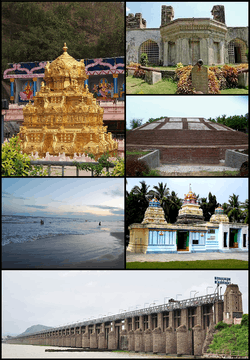 Clockwise from top-left: Kanaka Durga Temple, Kondapalli Fort, Buddhist remains in Ghantasala, Lord Andhra Vishnu temple, Prakasam Barrage, Manginagudi beach in Machilipatnam | |
 Location of Krishna district in Andhra Pradesh | |
| Coordinates (Machilipatnam): 16°17′N 81°13′E | |
| Country | India |
| State | Andhra Pradesh |
| Division | Krishna district |
| Headquarters | Machilipatnam |
| Tehsils | 50 |
| Government | |
| • District collector | Imthaj |
| • Lok Sabha constituencies | Vijayawada, Machilipatnam, |
| • Vidhan Sabha constituencies | 16 |
| Area | |
| • Total | 8,727 km2 (3,370 sq mi) |
| Population (2011) | |
| • Total | 4,517,398 |
| • Density | 520/km2 (1,300/sq mi) |
| • Urban | 40.81% |
| Demographics | |
| • Literacy | 73.74% |
| • Sex ratio | 992 |
| Vehicle registration | AP-16 (former) AP–39 (from 30 January 2019)[1] |
| Major highways | AH-45, NH-65, NH-221, NH-216 |
| Website | krishna |
The Krishna District was formed from District of Rajahmundry in 1859, when it also included the present day Guntur and West Godavari districts. Guntur was separated from Krishna in 1904, and West Godavari in 1925, giving rise to the present day Krishna district.[3][4]
Etymology
Krishna district, with its district headquarters at Machilipatnam was formerly called Machlipatnam district. Later it was renamed as Krishna district, by adding certain Taluks of the abolished Guntur District in 1859 with Machilipatnam with its head. It was named after the Krishna River, the third longest river in India. The river flows through the state of Andhra Pradesh before it empties itself into Bay of Bengal, near Hamsaladevi village of Krishna district.[2]
History


This history of this region dates back to the 2nd century BCE. The area was ruled by the Satavahanas (230 BC – AD 227); Pallavas (AD 340 – AD 500), Chalukyas (AD 615 – 1070 AD) and later by Cholas, Kakatiyas, Musunuri Nayaks, Reddy dynasty and Gajapati kings of Odisha.[5]
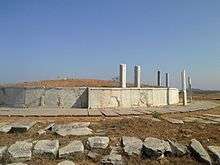
Satavahana period (230 BC – AD 227): The Satavahanas ruled this region with headquarters at Srikakulam. Prominent rulers during this period were Srimukha (founder), Gotamiputra Satakarni and Yajnasri Satakarni (last Satavahana king). The Satavahanas imparted more stability and security to the life of the people of the region for more than four centuries. Pallava Kingdom (AD 340 – AD 500), spread over from Krishna river to Tungabhadra, including Amaravati in the East, Bellary in the West and Kancheepuram in the South with capital cities at venginagar near Eluru and Pithapuram, both in Vengidesa. Bruhitpalayanas, the contemporaries of Pallavas who ruled the district with Koduru as their capital. Vishnukundinas (AD 5th century), are rulers who excavated cave temples at Mogalrajapuram (now in Vijayawada) and Undavalli, etc. Eastern chalukyas (AD 615 – AD 1070), the entire Andhra country was under the control of a single ruler under their reign. The Eastern Chalukyas were credited with the excavations of the cave temple at Undavalli and rock cut shrines and Shiva temples.[5]
Cholas ruled this region with capital at Rajamahendri . It was during Rajarajanaredra's reign that Nannayya Bhattu translated the Mahabharata into Telugu. Kakatiyas, ruled this region up to the early 14th century with Orugallu as their capital and followed by Musunuri Nayaks who rebelled against Delhi sultanate and won. Musunuri Nayaks constructed various forts in South India including Hampi and ruled many states of India independently. Reddy dynasty, on the downfall of Pratapa Rudra of Kakatiya, the eldest son of Prolaya Vema reddi, a subordinate of Musunuri Kapaya Naidu found himself independent and established himself in the hill fort of Kondavedu. The Kondavidu Reddi's were great patrons of Telugu literature. The poet Srinadha and his brother-in –law Bammera Pothana flourished at his court. The ruins of fortresses at Kondavidu can be seen[5]
Gajapathis of Odisha: Kapileswara Gajapathi is preserved by the village Kapileswarapuram now in Pamidimukkala mandal. He was succeeded by Vidyadhara Gajapathi who built Vidyadharapuram (now in Vijayawada) and constructed a reservoir at Kondapalli. Krishnadevaraya of Vijayanagara empire conquered this region in the early 16th century. Qutb Shahis, in 1512, the Kingdom of Golconda was founded by one Sultan Quli Qutub Shah. The Kingdom of Golconda included this district within its limits. Abu-l-Hussain Shah was the last of Qutab Shahi dynasty known as Tanisha. He had two ministers, both Brahmins, named Madanna and Akkanna. Popular tradition attributed this preference of Vijayawada to the devotion of the two ministers to the goddess Kanaka Durga.[5]
Medieval period
Nizams: The Emperor Aurangazeb included this district in the province of Golconda, which remained under Asaf jah who was appointed as Subedar or Viceroy of the Deccan in AD 1713 with the title of Nizam-ul-Mulk. The province of Golconda comprised five Nawabs’ charges viz. Arcot, Cuddapah, Kurnool, Rajahmundry and Chicacole (Srikakulam). The Nawab of Rajahmundry ruled the country induced in the Krishna district.[5]
The British: In the year 1611 the English founded their settlement at Masulipatnam which was their headquarters until they finally moved to Madras in 1641. The Dutch and French also had settlements at Masulipatnam. Upon the death of the old Nizam-ul-Mulk in June 1748 his heirs strove for the succession with the support of the English and the French. When Nizam Ali Khan was proclaimed ruler of Golconda in 1761 the British secured at first the divisions of Masulipatnam, Nizampatnam and part of Kondaveedu and later the entire Circars. At first the district was administered by a chief and council at Masulipatnam but in 1794 Collectors, directly responsible to the Board of Revenue, were appointed at Masulipatnam.[5]
Demographics
As of 2011 census of India, the district had a population of 4,517,398 with a density of 518 persons per km2. The total population constitute, 2,267,375 males and 2,250,023 females –a ratio of 992 females per 1000 males. The total urban population is 1,843,660 (40.81%).[4]:20 There are 3,009,718 literates with a literacy rate of 73.74%.[4]:21
| Year | Pop. | ±% p.a. |
|---|---|---|
| 1901 | 861,068 | — |
| 1911 | 993,086 | +1.44% |
| 1921 | 1,059,731 | +0.65% |
| 1931 | 1,229,176 | +1.49% |
| 1941 | 1,413,516 | +1.41% |
| 1951 | 1,736,429 | +2.08% |
| 1961 | 2,076,956 | +1.81% |
| 1971 | 2,493,574 | +1.84% |
| 1981 | 3,048,463 | +2.03% |
| 1991 | 3,698,833 | +1.95% |
| 2001 | 4,187,841 | +1.25% |
| 2011 | 4,517,398 | +0.76% |
| source:[6] | ||
Geography
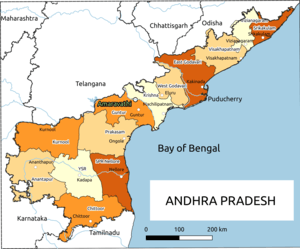
The Krishna District is in the eastern coast of the state bordering West Godavari district in the East, Bay of Bengal in the South, Guntur and Suryapet district of Telangana in the West and Khammam district of Telangana in the Northern direction. The Krishna district occupies an area of 8,727 square kilometres (3,370 sq mi),[7] It has a total coastline of 88 km (55 mi).[8]
Topography
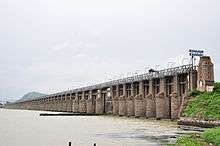
The main hill range of the district known as Kondapalli runs between Nandigama and Vijayawada with a length of about 24 km. The other smaller hill ranges are Jammalavoidurgam, Mogalrajapuram and Indrakiladri hills. Kolleru, is the large freshwater lake in India. It spans into two districts – Krishna and West Godavari.
Flora and fauna
The forest occupies only 9 percent of the total district area. However, it contains Reserved Forest areas in Nandigama, Vijayawada, Tiruvuru, Nuzvid, Gannavaram, Machilipatnam and Divi Seema Talukas. A type of light wood known as ‘Ponuku’ (Gyrocapus Jacquini) is found in the Kondapalli hills. The wood is used for the manufacture of the well known Kondpalli toys. The most noticeable trees are pterocarpus, Terminalia, Anogeissus and Logustroeinai and Casuarina.[9]
Panthers, hyenas, jungle cats, foxes, bears and other carnivorous mammalian fauna are found here. Deer, spotted deer sambar, blackbuck and other herbivorous animals are found in the inland forests. The district has a large number of Murrah buffaloes and cows.[9]
Climate
The climatic conditions of the district consist of extremely hot summers and moderately hot winters and may be classified as tropical. The period starting from April to June is the hottest. The annual rainfall in the region is about 1028 mm and is contributed to by the Southwest monsoon. Three types of soils viz., Black Cotton (57.6 percent), Sand clay loams (22.3 percent) and Red loams (19.4 percent).
| Climate data for Vijayawada (1951–1980) | |||||||||||||
|---|---|---|---|---|---|---|---|---|---|---|---|---|---|
| Month | Jan | Feb | Mar | Apr | May | Jun | Jul | Aug | Sep | Oct | Nov | Dec | Year |
| Average high °C (°F) | 30.0 (86.0) |
32.7 (90.9) |
35.4 (95.7) |
37.4 (99.3) |
39.8 (103.6) |
37.2 (99.0) |
33.2 (91.8) |
32.4 (90.3) |
32.6 (90.7) |
31.8 (89.2) |
30.7 (87.3) |
29.6 (85.3) |
33.6 (92.5) |
| Average low °C (°F) | 18.7 (65.7) |
20.1 (68.2) |
22.4 (72.3) |
25.5 (77.9) |
27.5 (81.5) |
27.0 (80.6) |
25.4 (77.7) |
25.1 (77.2) |
25.1 (77.2) |
24.0 (75.2) |
21.3 (70.3) |
19.1 (66.4) |
23.4 (74.1) |
| Average precipitation mm (inches) | 0.9 (0.04) |
5.3 (0.21) |
9.6 (0.38) |
14.3 (0.56) |
51.3 (2.02) |
131.9 (5.19) |
218.4 (8.60) |
185.6 (7.31) |
163.5 (6.44) |
142 (5.6) |
51.3 (2.02) |
6.7 (0.26) |
998.2 (39.30) |
| Average precipitation days | 0.1 | 0.4 | 0.5 | 1.0 | 3.1 | 7.6 | 12.6 | 11.5 | 8.8 | 7.1 | 2.8 | 0.6 | 56.1 |
| Source: India Meteorological Department. | |||||||||||||
Economy
The Gross District Domestic Product (GDDP) of the district is ₹62,726 crore (US$8.8 billion) and it contributes 12% to the Gross State Domestic Product (GSDP). For the FY 2013–14, the per capita income at current prices was ₹104,897 (US$1,500). The primary, secondary and tertiary sectors of the district contribute ₹17,780 crore (US$2.5 billion), ₹8,967 crore (US$1.3 billion) and ₹35,979 crore (US$5.0 billion) respectively.[8]
The major products contributing to the GVA of the district from agriculture and allied services are, paddy, sugarcane, mango, tomato, milk, meat and fisheries. The GVA to the industrial and service sector is contributed from construction, electricity, manufacturing, transport and software services.[8]
Divisions
The district has four revenue divisions, namely Vijayawada, Nuzvid, Machilipatnam and Gudivada, each headed by a sub collector. These revenue divisions are divided into 50 mandals in the district. These 50 mandals consists of 49 mandal parishads, 973 panchayats, 1005 villages and 5 municipalities.[10] There are 20 towns (or urban settlements) in the district, including 1 municipal corporation, 5 municipalities, 3 nagar panchayat and 11 census towns. Vijayawada city is the only municipal corporation and the 5 municipalities in the district are Gudivada, Jaggaiahpeta, Machilipatnam, Nuzivid and Pedana. Vuyyuru, Nandigama and Tiruvuru were constituted as nagar panchayats in the year 2011. The 11 census towns are Kanuru, Poranki, Tadigadapa, Yanamalakuduru, Kankipadu, Ramavarappadu, Prasadampadu, Guntupalli, Ibrahimpatnam, Kondapalle, Tiruvuru.[11]
Mandals
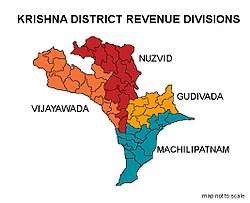

The list of 53 mandals in Krishna district[12] under 4 revenue divisions are listed in the following table:
Politics
Krishna district has two parliamentary constituencies namely, Vijayawada and Machilipatnam. There are 16 assembly constituencies namely, Tiruvuru (SC), Nandigama (SC), Mylavaram, Jaggayyapeta, Vijayawada West, Vijayawada Central, Vijayawada East, Penamaluru, Nuzvid, Gannavaram, Pedana, Gudivada, Kaikaluru, Machilipatnam, Avanigadda, Pamarru (SC).[13] Telugu Desam Party, Janasena party, YSR Congress, Bharatiya Janata Party, Lok Satta, CPI and CPM are the main political parties in the district.
Culture
The culture of Krishna district is mostly traditional in rural places and moderately modern in Vijayawada. It is also famous as the birthplace for Indian classical dance named kuchipudi and the culture with the dialect of Telugu spoken in Krishna is widely considered to be the standard form of Telugu.[14]
Transport
The total road length of state highways in the district is 1,188 km (738 mi).[15] There exists 97 km (60 mi) of rail network in the district.[8] Four national highways pass through the district namely NH16 from Chennai to Kolkata, NH 65 from Pune to Machilipatnam, NH 221 from Vijayawada to Jagdalpur, NH 214 Kathipudi to Pamarru, NH 214A Digamarru to Ongole.
Education
The primary and secondary school education is imparted by government, aided and private schools, under the School Education Department of the state.[16][17] As per the school information report for the academic year 2015–16, there are a total of 4,449 schools. They include, 15 government, 2,432 mandal and zilla parishads, 3 residential, 1748 private, 2 model, 3 Kasturba Gandhi Balika Vidyalaya (KGBV), 180 municipal and 66 other types of schools.[18] The total number of students enrolled in primary, upper primary and high schools of the district are 562,510.[19]
NTR University of Health Sciences is located in Vijayawada. Krishna University is located in Machilipatnam. Rajiv Gandhi University of Knowledge Technologies, Nuzvid is situated in Nuzvid. School of Planning and Architecture, South Indian Chapter is present in Vijayawada.
District has numerous engineering colleges including Prasad V. Potluri Siddhartha Institute of Technology, Velagapudi Ramakrishna Siddhartha Engineering College, Lakireddy Bali Reddy Engineering College, Gudlavalleru Engineering College, DMS SVH College of Engineering, SRR & CVR Govt. Degree College is one of the oldest College. it was establieshed in 1937. Govt Polytechnic Vijayawada (one of the oldest Polytechnic colleges in India), Andhra Loyola College, AANM & VVRSR (Gudlavalleru) Polytechnic College, Mary Stella college, Sidhartha Degree College are few of the many famous arts and science colleges in the district.
Sports
Kabbadi is the most popular sport, followed by cricket, volleyball, badminton, basketball and tennis.
Indira Gandhi Municipal Stadium in Vijayawada hosts One Day Internationals Cricket matches of India. Only one international cricket match was played between India and West Indies on 24 November 2002 at Indira Gandhi stadium. It was won by West Indies. On 12 December 1997 Women's Cricket Worldcup only a group match was played between England Women's Cricket Team and Pakistan women's cricket team, and it was won by England. Dandamudi Rajagopal Indoor Stadium in Vijayawada .
NTR Stadium is the main sports venue in Gudivada. It is used for several sports, like athletics, volleyball, cricket practice, kho kho, kabaddi, badminton, tennis and basketball.[20] Famous Hockey player Balram belongs to this District.
It is also the stadium for Krishna District Cricket Association. Mangalagiri International Cricket Stadium is being built in a 20-acre (8.1 ha) site in Navuluru, village of Mangalagiri town, Guntur district, about 15 km from the city of Vijayawada. The exclusive stadium of the Andhra Cricket Association will be the venue for international and Ranji matches.[21]
Notable people
Many notable people are associated with this district, including:
Science and technology
- Kakarla Subba Rao
- Prof. Kanuri Lakshmana Rao, engineer
- Veluri Venkata Krishna Sastry, archaeologist and historian
Fine arts and literature
- Tripuraneni Ramaswamy (Lawyer, playwright, poet, Avadhanam)
- Dr. Mangalampalli Balamuralikrishna
- Gudipati Venkatachalam
- Jaladi Raja Rao (lyricist)
- Mahakavi Kshetrayya
- Nanduri Venkata Subba Rao (poet)
- Satyam Sankaramanchi (Amaravati Kathalu)
- Siddhendra Yogi (architect)
- Vempati Chinna Satyam (promoter of Kuchipudi dance)
- Veturi Sundararama Murthy
- Yaddanapudi Sulochana Rani
- Viswanatha Satyanarayana
Social reformers
- Dr. Jayaprakash Narayan (president of Loksatta Party)
- Duggirala Gopalakrishnayya Andhra Ratna
- Kasinadhuni Nageswara Rao (Andhra Patrika)
- Pingali Venkayya (designer of Indian National Flag)
Sports
- C.K Nayudu (cricket)
- Chetan Anand (badminton)
- Dandamudi Rajagopal (weightlifting)
- Koneru Humpy (chess)
Cinema
- Nandamuri Taraka Rama Rao
- Akkineni Nageswara Rao
- Dandamudi Rajagopal
- Chandra Mohan
- Gadde Rajendra Prasad
- Ghantasala Venkateswara Rao
- Jandhyala Subramanya Sastry
- Kaikala Satyanarayana
- Kota Srinivasa Rao
- Mani Sharma
- Nirmalamma
- Nutan Prasad
- Raghupathi Venkaiah Naidu
- Ramoji Rao Cherukuri
- S. V. Ranga Rao
- Sobhan Babu
- Suthi Veerabhadra Rao
- Suthivelu
- Veturi Sundararama Murthy
References
- "New 'AP 39' code to register vehicles in Andhra Pradesh launched". The New Indian Express. Vijayawada. 31 January 2019. Retrieved 9 June 2019.
- "Krishna district". AP state portal. Archived from the original on 6 February 2016. Retrieved 18 January 2016.
- "Archived copy" (PDF). Archived from the original (PDF) on 24 July 2015. Retrieved 20 June 2015.CS1 maint: archived copy as title (link)
- "District Census Handbook – Guntur" (PDF). Census of India. The Registrar General & Census Commissioner. Retrieved 13 May 2016.
- "History". Krishna district website. Archived from the original on 29 February 2016. Retrieved 23 September 2015.
- Decadal Variation In Population Since 1901
- Srivastava, Dayawanti (2010). "States and Union Territories: Andhra Pradesh: Government". India 2010: A Reference Annual (54th ed.). New Delhi, India: Additional Director General, Publications Division, Ministry of Information and Broadcasting (India), Government of India. pp. 1111–1112. ISBN 978-81-230-1617-7.
- "Economy of Krishna District". Andhra Pradesh Economic Development Board. Retrieved 25 April 2017.
- "Flora and Fauna of Krishna district". AP forest department. Archived from the original on 25 January 2014. Retrieved 14 July 2014.
- "Administrative Setup". Krishna District Official Website. Archived from the original on 20 October 2014. Retrieved 20 November 2014.
- "District Census Handbook – Krishna" (PDF). Census of India. p. 17. Retrieved 18 January 2015.
- "new Mandals in vijaywada District". The Times of India. Retrieved 18 December 2017.
- "Assembly Constituencies – Krishna district" (PDF). Geographic Information Systems. Archived from the original (PDF) on 17 April 2012. Retrieved 15 July 2014.
- "District profile". Krishna District. National Informatics Centre. Archived from the original on 12 June 2014. Retrieved 16 June 2014.
- "Existing State Highways" (PDF). Andhra Pradesh Road Development Corporation. Government of Andhra Pradesh. p. 1. Archived from the original (PDF) on 20 September 2018. Retrieved 11 May 2019.
- "School Education Department" (PDF). School Education Department, Government of Andhra Pradesh. Archived from the original (PDF) on 21 October 2016. Retrieved 7 November 2016.
- "The Department of School Education – Official AP State Government Portal". ap.gov.in. Archived from the original on 7 November 2016. Retrieved 7 November 2016.
- "School Information Report". Commissionerate of School Education. Government of Andhra Pradesh. Archived from the original on 8 November 2016. Retrieved 8 November 2016.
- "Student Information Report". Commissionerate of School Education. Child info 2015–16, District School Education – Andhra Pradesh. Archived from the original on 22 May 2015. Retrieved 8 November 2016.
- "NTR Stadium all set to become more sporty". The Hindu.
- "Andhra Pradesh / Vijayawada News: Keeping home turf in top shape". The Hindu. 4 February 2007. Retrieved 30 January 2012.
External links
| Wikimedia Commons has media related to Krishna district. |
| Wikisource has the text of the 1911 Encyclopædia Britannica article Kistna (district). |